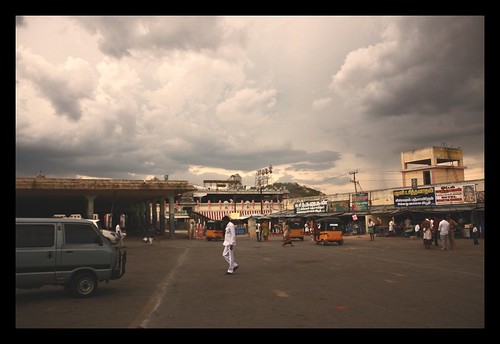Palani (100 km west of Madurai),Swamimalai (150 km east of Madurai),Tirupparangunram (5 km from Madurai),Pazhamudircholai (10 km north of Madurai) and Thiruchendur (100 km south of Madurai).
The temple is located in the township of Tiruttani 50 km north of Chennai en route to Thirupathi. According to Hindu mythology, Lord Murugan married Valli, the daughter of a hunting tribe cheiftain, here.

History
The origins of this temple, like most Hindu temples, are buried in antiquity. This temple has been mentioned in the Sangam period work Tirumurugaatruppadai composed by Nakkeerar. It has been patronized by the Vijayanagar rulers and local chieftains and zamindars.
Mythology
Legend also has it that Indra the king of the Gods gave his daughter Deivayanai in marriage to Skanda, and along with her presented his elephant Airavatam as part of his dowry offering. Upon Airavatam’s departure Indra found his wealth waning. Subramanyar is said to have offered to return the white elephant, however Indra bound by protocol refused to accept a gift that he had made, and insisted that the elephant face his direction, hence the image of the elephant in this temple also faces the east.
Murugan tricking Valli by posing as an old man, along with Vinaya posing as an elephant .Another legend has it that Indra presented a sandal stone as a part of his daughters dowry. The sandal paste made on this stone is applied to the image of Subramanya and the applied paste is said to acquire medicinal value. Legend also has it that Skanda bore the discus thrown by the demon Tarakasuran on his chest, and hence there is a hollow in the chest region of the image of Subramanya in this temple. Legend also has it that Skanda gifted the discus to Vishnu (Please also see Tiruveezhimizhalai and Tirumalper). Skanda is also believed to have imparted knowledge of Tamil to the sage Agasthyar and he is regarded as Veeram

Lord Rama, after putting an end to Ravana, worshipped Lord Siva at Rameswaram and then came to Tiruttani to find perfect peace of mind by worshipping Lord Subrahmanya here. In Dwapara Yuga, Arjuna got the blessings of our Lord here by offering prayers to Him on his way to the South for Teertha Yatra (pilgrimage to take sacred immersion). Lord Vishnu prayed to the Lord and got back His powerful Chakra (sacred wheel), Shanku (sacred conch), which were forcibly seized from Him by Tarakasura, brother of Soorapadma. Lord Brahma propitiated the Lord here at the holy spring known as Brahmasonai after his imprisonment by our Lord for his failure to explain the Pranava (’Om’ mantra) and got back his creative function of which he was deprived by our Lord due to his egotistic impudence in neglecting to worship Lord Subrahmanya on his way to Mount Kailasa to worship Lord Siva. The final steps to the eastern entrance.

On worshipping our Lord at Thanikai, the king of snakes Vasuki got his bodily wounds healed, which had been caused during the churning process in the Milky Ocean to secure the Amrita (nectar of immortality) by the devas and asuras when the Mantotra Mountain was used as the churning base and the snake king Vasuki as the rope. Sage Agasthyar Muni (of Potikai Hill) worshipped Lord Muruga at Tanikai when he was blessed with the divine gift of the Tamil language.
Significance of the temple

Apart from its puranic greatness, Saint Arunagirinathar has praised this hill as the chosen place for worship by devas and the favorite abode of saints performing prolonged tapas. He also compared this hill to Sivaloka (Bhuloka) and as the very soul of the world. Sri Muttuswami Deekshitar, who lived 200 years ago (one of the trinity of Karnatic music) had his inspiration in Tiruttani when the Lord (in the guise of an old man) met him on the steps and sweetened his tongue with the prasadam of this temple, which impelled him to sing his first song on Lord Murugan of Tanikai.
The famous Teppam festival
Festivals
Besides the monthly Krittikais which attract a large number of devotees to this shrine, the two outstanding annual festivals are the Aadi Krittikai and the 31st of December New Year Step Festival. The float festival is celebrated in the month of Aadi, Bhramotsavam in the month of Maasi, during which Valli Kalyanam is celebrated on the 8th day, and the Skanda Sashti is celebrated in the Tamil month of Aippasi.
[edit]Aadi Krittikai
Aadi Krittikai festival (in July-August) lasts for three days with Float Festival when hundreds of thousands of devotees come to this holy place from far and near. The streets are thronged to the full. About one fifty thousand flower kavadis (which increase with each year) are offered to the deity. The sight of the devotees who carry them, uttering the sacred and inspiring “Haro Hara!” as they march and dance in long rows touches the very core of devotees’ hearts and makes them spellbound.
December 31st Step Festival
When the new year srikes on 31st dec midnight, hundreds of thousands of devotees are present on the sacred Tanikai hill to have the darshan of their Lord. They come to Tiruttani to offer their heart-felt prayers to our Lord on that day and night to be blessed with peace and plenty during the New Year. This festival came into vogue during the British Raj when the famous Vallimalai Swamigal persuaded his followers to offer their homage first to Lord Tanigesan, the giver of all good, and only then to their official bosses. On this day, numerous bhajana parties gather and ascend the hill, singing the melodious Tiruppugazh songs and burning camphor on each of the hill’s 365 steps, one for each day of the New Year.